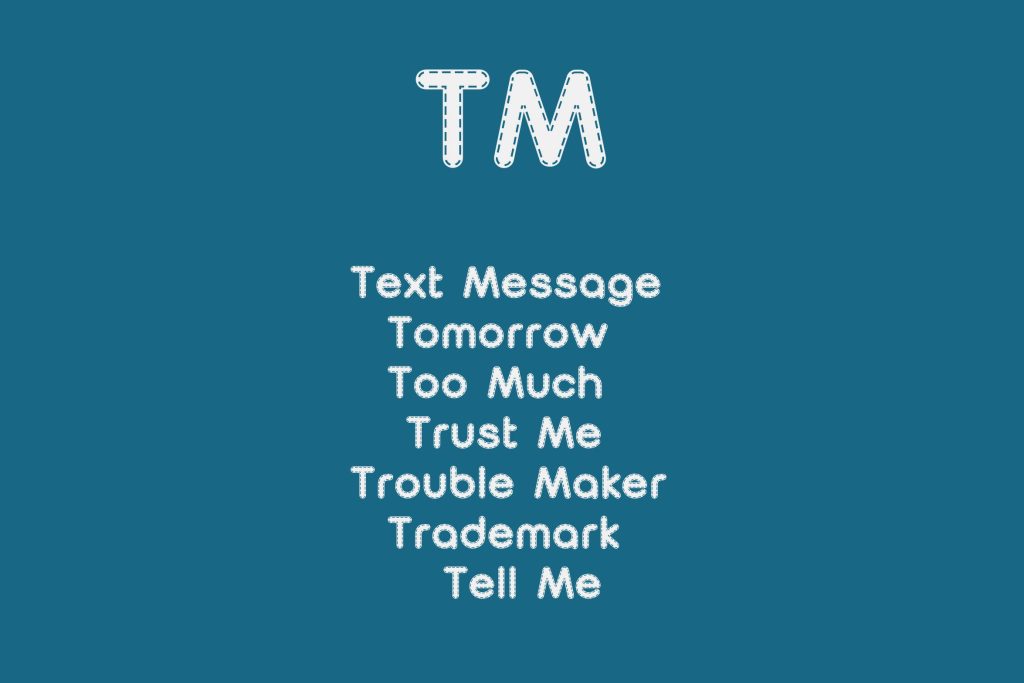The abbreviation “TM” is a versatile term that appears frequently in text messages, social media posts, and even professional contexts. Its meaning changes depending on how and where it’s used, which can sometimes make it confusing.
From casual conversations to legal or technical discussions, “TM” has a wide range of interpretations.
In this article, I’ll talk about various meanings of “TM,” explain how to understand its context, and provide examples to help you use it effectively.
Common Meanings of TM
1. Text Message
One of the most common meanings of TM is “Text Message.” This usage is straightforward and widely recognized in casual conversations. People often use TM as a shorthand to save time when referring to sending or receiving a text message. For example:
- “I’ll send you a TM when I’m on my way.”
- “Did you get my TM last night?”
Using TM in this way is especially popular among younger generations who are accustomed to abbreviating words while texting or chatting online. It’s also useful when you’re typing quickly or trying to fit your message within character limits, such as on platforms like Twitter.
The meaning is usually clear from the context. If someone is talking about communication or phones, it’s safe to assume they mean “Text Message.” However, if the conversation shifts to other topics, TM might take on a different meaning.
2. Tomorrow
Another very popular interpretation of TM is “Tomorrow”, which is widely used in informal conversations when people want to refer to the next day without typing out the entire word. For instance:
- “Let’s meet up tm for lunch.”
- “I’ll finish that assignment tm, I promise!”
It is especially common in social media captions, direct messages (DMs), and group chats where brevity is key. For example, someone might post a photo with the caption:
- “Big announcement coming tm!”
TM for “Tomorrow” adds a casual tone to your message and makes it feel more conversational. However, it’s important to ensure that your audience understands what you mean. If someone isn’t familiar with this abbreviation, they might misinterpret your message.
3. Too Much
TM can also stand for “Too Much,” often used to express feelings of being overwhelmed or something being excessive. It is more emotional and is commonly used in situations where someone wants to emphasize their reaction to an event, experience, or even a person. For example:
- “That party last night was TM! I’m exhausted.”
- “Her outfit was TM—it was so over-the-top!”
This version of TM often appears in casual conversations among friends or in social media comments where people react strongly to something. It can be used positively or negatively depending on the context:
- Positive: “That dessert was TM—it was so good!”
- Negative: “The workload this week has been TM—I need a break.”
When using TM as “Too Much,” it’s all about expressing strong emotions in a concise way.
4. Trust Me
In some cases, people use TM to mean “Trust Me.” It is often seen when someone wants to reassure another person or emphasize their confidence in what they’re saying. For example:
- “TM, you’re going to love this movie!”
- “It’ll work out fine—TM.”
It adds a personal touch and shows that the speaker feels strongly about their statement. It’s often used among close friends or family members where there’s already a sense of trust and familiarity.
5. Trouble Maker
Another playful interpretation of TM is “Trouble Maker”, which is often used humorously or affectionately to describe someone who stirs up mischief or causes lighthearted chaos. For example:
- “You’re such a TM—you always find a way to make things interesting!”
- “That kid is a total TM; he’s always getting into something.”
As you can imagine, such usage is common among friends who like to joke around with each other. It’s rarely meant in a serious or negative way; instead, it’s usually said with affection or admiration for someone’s adventurous spirit.
On social media platforms like TikTok or Instagram, people might use this meaning when commenting on funny videos or posts that show someone being mischievous.
Other Meanings of TM
1. Trademark

One of the more formal meanings of TM is “Trademark.” The ™ symbol is often seen next to brand names, logos, slogans, or product names to indicate that they are legally protected intellectual property. For example:
- “Our company just registered its logo with the ™ symbol.”
- “That slogan has been trademarked—don’t use it without permission.”
While this meaning isn’t commonly used in casual conversations, it’s important in business and legal contexts. Trademarks help protect brands from being copied or misused by others.
If you see TM used in professional settings—such as emails, advertisements, or product packaging—it almost always refers to “Trademark.”
2. Tell Me
In texting and online chats, TM can also mean “Tell Me.” It invites someone to share more information about something they’ve mentioned. It demonstrates curiosity and interest in what the other person has to say. Meanwhilem, it encourages further conversation and helps keep the dialogue flowing naturally. For example:
- “TM about your trip! How was it?”
- “TM what happened at the meeting today—I missed it.”
3. Technical Manual
In certain fields like engineering, IT, or manufacturing, TM might stand for “Technical Manual.” These are detailed documents that provide instructions for operating equipment, software, or machinery. For example:
- “Make sure you read the TM before using this device.”
- “The troubleshooting section in the TM should help solve that issue.”
4. Transcendental Meditation
Another niche meaning of TM is “Transcendental Meditation,” which refers to a specific form of meditation that involves silently repeating a mantra for relaxation and stress relief. For example:
- “I’ve been practicing TM for years—it really helps me stay calm.”
- “Have you tried TM? It’s great for reducing anxiety.”
How Context Shapes the Meaning of TM
The key to understanding what someone means by “TM” lies in its context. A single abbreviation can have multiple interpretations depending on where it appears:
- Casual Conversations: In texting or chatting with friends, meanings like “Text Message,” “Tomorrow,” or “Too Much” are most likely.
- Social Media: On platforms like Instagram or TikTok, people might use meanings like “Trust Me,” “Trouble Maker,” or even “Too Much.”
- Professional Settings: In emails or work-related discussions, meanings like “Trademark” or “Technical Manual” are more appropriate.
- Specialized Topics: In wellness circles, you might come across references to Transcendental Meditation.
TM on Social Platforms
On Instagram, users often use TM in captions or comments with meanings like:
- “That outfit is TM!” (Too Much)
- “DM me tm.” (Tomorrow)
Snapchat
On Snapchat, TM might appear in casual chats as:
- “I’ll send you a pic tm.” (Tomorrow)
- “TM, it’s going to be fun!” (Trust Me)
TikTok
TikTok creators might use TM in video captions with meanings such as:
- “This dance move is TM!” (Too Much)
- “Try this recipe tm.” (Tomorrow)





